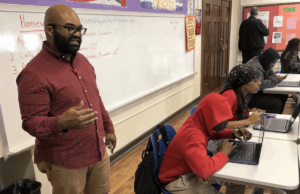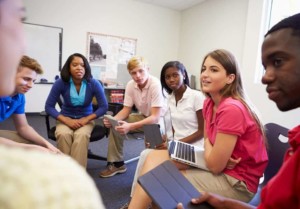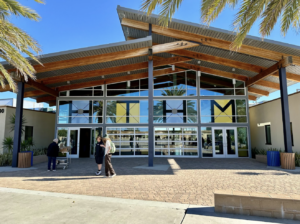High Quality PBL Framework on the Horizon

During my classroom days, before students launched into “work time” during Project Based Learning (PBL) units, I had my students fill out daily “action plans” where they wrote down what they were going to do that day.
Of course, the kids didn’t want to make action plans (I often heard audible groans) — they just wanted to get to work. But if I turned students loose to do their work without planning, they often wouldn’t make any forward progress. Or, if they did, each student was rarely rising to their personal potential.
By having students start each day by thinking through what they had to get done, and how they would accomplish it, they were taking steps toward developing the vital and transferable skill of project management.
The Need for HQPBL
As the world has changed dramatically over the last decades, educators, community/business leaders and parents have become increasingly aware of how skills like project management are essential to students’ future success. Today’s workplace often requires employees to collaborate in teams, solve complex problems, communicate effectively–and organize their work as a series of projects. More and more people are part of the “gig economy,” doing one project after another. The need to prepare students for this new reality has become clear to more and more educators, who are turning to PBL as a solution.
Unfortunately in education, new instructional practices sometimes become trendy fads that don’t live up to their promise. Teachers, school leaders, consultants, and curriculum developers may jump on the PBL bandwagon and, if the quality of the resulting projects is low, abandon the approach. To help mitigate this possibility, a steering committee of 25 PBL experts and organizations has created a framework called High Quality Project Based Learning, or HQPBL. They are now working to promote the framework for wide national and international adoption. The year-long process was facilitated by the Buck Institute for Education and Getting Smart with support from the Project Management Institute Educational Foundation and the William and Flora Hewlett Foundation.
It has been exciting to watch the HQPBL framework take shape. As a core part of the Framework, the steering committee has defined six criteria that describe what we should see students experiencing when they are engaged in high quality PBL. As we near the release of version one of the framework, I want to offer a peek into some of the thinking you can expect from the final framework, starting with one of the six criteria: project management.
A Renewed Focus on Project Management
Finding inspiration in the work of organizations like Project Management Institute Educational Foundation, one of the major places that the HQPBL team has been putting new emphasis is around project management. Whereas in the past, reference to project management in PBL was largely focused on the teacher experience (having them make a clear schedule for student work, define check-in points, etc.) the HQPBL committee has helped reframe project management goals around the student experience.
The new framework highlights the need to support students in setting their own goals, creating action plans, and assessing their own progress as they move through a project. It will set up and encourage students to work as independently as possible, to manage time on their own and as a team, and to use management tools and strategies with guidance from teachers. This shift from teacher-centered instruction will have a profound impact on students and the learning they take away from their education.
Equity and Post-High School Success
For many students, the ability to self manage is something that’s learned from parents at home, or taught in extracurriculars after school. However, not all students find that support outside of school. And so, the ability to build student’s project management skills is another great way that PBL can help deliver a more equitable education. Making sure that learning these skills is part of in-school instruction would mean a great deal in helping equip all students for work after they graduate high school and move on to college and career. Beyond subject matter mastery, this is the kind of work that is needed to truly close the achievement gap.
When I was leading the Envision Schools, I remember speaking at one particular event in front of 200 educators from Alameda County. I was happy to be able to get one of our very recent graduates, Alexis, to come in and talk to the crowd about his experiences in his first semester at college.
Toward the end of the semester, Alexis told the crowd a story about being given a massive assignment for a course — an assignment that was due the day after a really important basketball game. The assignment involved lots of reading, writing, and collaborating with other students. A true basketball fan, Alexis felt some understandable dread, thinking he might fall victim to procrastination that could find him scrambling, on the night of the game, to finish this huge assignment for the next day.
Alexis did what any good PBL-educated student should do: he made a plan. He took this large assignment and drew up a plan for chunking it out into digestible pieces with daily benchmarks that he could work toward and complete day by day.
He finished his assignment in time to make the game, and to really enjoy it knowing that he was well prepared for class the next day. This is what project management is all about: feeling equipped to define, plan, execute, and review a course of action to accomplish what needs to be done.
A PBL education should leave students feeling like Alexis: excited to learn, and ready to manage their own learning.
For more, see:
- Can Students Learn Entirely on their Own?
- How to Create & Cultivate PBL Culture
- What Makes High Quality PBL
Stay in-the-know with all things EdTech and innovations in learning by signing up to receive the weekly Smart Update. This post includes mentions of a Getting Smart partner. For a full list of partners, affiliate organizations and all other disclosures, please see our Partner page.







0 Comments
Leave a Comment
Your email address will not be published. All fields are required.